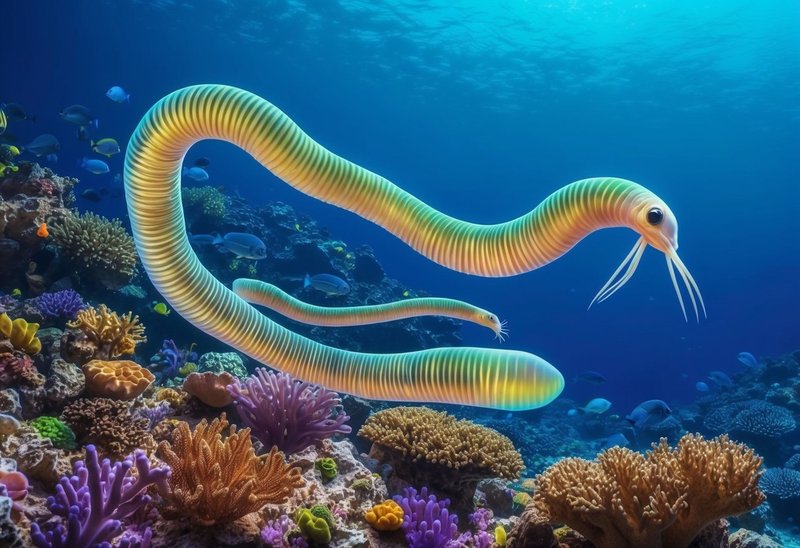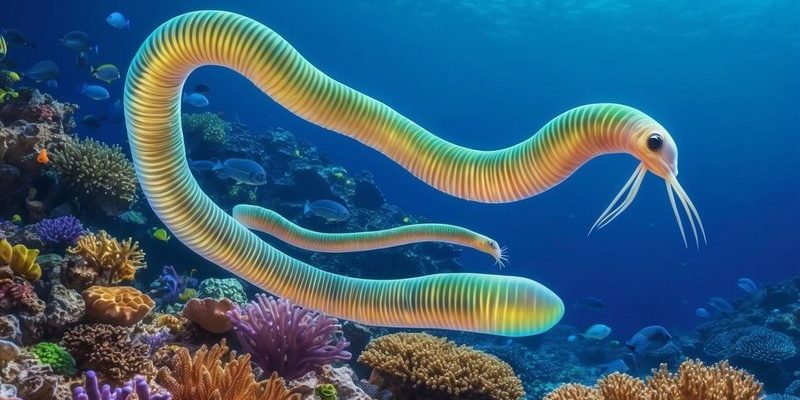
Bobbit worms belong to the family *Eunice*, and they can grow several feet long. These worms stay mostly buried in the sediment with just their colorful, feathery heads peeking out. Their unique adaptations and hunting strategies make them one of the ocean’s more intriguing inhabitants. But what do they actually do for our coastal ecosystems? Let’s dive into the ecological role of Bobbit worms and why they are essential for maintaining the health of our oceans.
What Are Bobbit Worms?
Bobbit worms, scientific name *Eunice aphroditois*, are fascinating annelids found primarily in tropical and subtropical coastal waters. They can grow up to 10 feet long and are mostly recognized by their strikingly beautiful, segmented bodies and vivid colors. Most of their life is spent camouflaged in sandy or muddy substrates, where they can be challenging to spot.
Their strategy for survival is quite clever. Bobbit worms extend their long, segmented body into the sediment, leaving only their feathery antennae exposed. This setup allows them to sense vibrations in the water, making it easier to detect potential prey. When a fish or other creature comes too close, the Bobbit worm strikes with lightning speed, using its powerful jaws to secure a meal. Have you ever seen a magician pull off a trick? The Bobbit worm’s ambush tactics can feel just as magical!
The Role of Bobbit Worms in the Food Chain
In any ecosystem, each creature plays a role in the delicately balanced food web, and Bobbit worms are no exception. As **predators**, they help regulate populations of smaller fish, crustaceans, and other marine organisms. This predation prevents any one species from becoming too dominant, allowing for a more diverse underwater community.
Here’s the thing—when one species starts to overpopulate, it can lead to significant ecological issues. Think of it like a garden where one plant takes over and chokes out the others. Bobbit worms help keep things in balance by controlling these populations. Their presence ensures that no single species can monopolize resources, leading to healthier ecosystems overall.
Let’s not forget, Bobbit worms also serve as prey themselves for larger marine creatures, such as fish and sea turtles. This makes them a critical link in the food chain. So, in a sense, you could call Bobbit worms both predators and prey—they’re the multitaskers of the ocean!
Impact on Sediment and Water Quality
Bobbit worms also play a significant role in **sediment turnover**. As they burrow into the sand and mud, they are constantly moving and aerating the substrate. This process increases the oxygen levels in the sediment, which is crucial for other organisms that live there, like tiny microbes and mollusks.
Additionally, their burrowing helps break down organic materials. Imagine if you were cleaning up your backyard—turning over soil allows nutrients to mix in and support new growth. Similarly, when Bobbit worms mix the sediment, they help recycle nutrients back into the ecosystem, enhancing overall water quality.
This constant interaction with the sediment not only supports the worms’ needs but also creates a healthier environment for many other marine species. Without this natural aeration process, coastal ecosystems would likely suffer from poor nutrient availability and lower overall biodiversity.
Bobbit Worms and Coral Reefs
Coral reefs are one of the most vibrant ecosystems on the planet. But you might be surprised to learn that even Bobbit worms play a role here. While they primarily inhabit sandy or muddy substrates, they can also live near coral reefs, where their predatory habits can help maintain the balance of reef life.
By preying on smaller fish and invertebrates that could harm coral, Bobbit worms help create a healthier environment for coral growth. Healthy coral reefs serve as essential habitats for countless marine species. When Bobbit worms are present, they contribute to the overall health of the reef community.
Moreover, the nutrients they add to the sediment can promote coral health directly. As they aerate the sediment, they encourage the growth of algae and other small organisms that corals rely on for sustenance. It’s like being an unsung hero in a vibrant underwater city that relies on teamwork for survival.
Threats to Bobbit Worm Populations
While Bobbit worms might seem tough, they face several threats that could impact their populations. One significant danger is habitat destruction. Coastal development, pollution, and activities like dredging can damage the habitats where Bobbit worms dwell. When their environment is altered or destroyed, their numbers can dwindle, leading to potential imbalances in the ecosystem.
Overfishing is another issue. When larger predators are removed from the ocean, it can lead to increases in Bobbit worm populations. This might sound good at first, but it can lead to overpredation on smaller species, creating a ripple effect that disrupts the food chain.
Climate change also poses a threat, with rising water temperatures and acidification affecting the delicate balance of coastal ecosystems. Bobbit worms, like many marine species, are sensitive to these changes. Protecting their habitats and managing fishing practices are essential steps we can take to ensure Bobbit worms continue to play their vital ecological role.
Conservation Efforts for Bobbit Worms
As awareness grows about the importance of Bobbit worms in our coastal ecosystems, conservation efforts are gaining traction. Many organizations are working to protect marine habitats through initiatives that focus on sustainable fishing practices and coastal restoration.
One of the most effective ways to help is by supporting local conservation groups that promote responsible fishing, clean-up efforts, and habitat restoration. Simple actions like reducing plastic use and advocating for cleaner oceans can also make a difference.
Engaging in community awareness programs can help educate others about Bobbit worms and their ecological importance. The more people know, the more likely they’ll take part in protecting our oceans. And who doesn’t want to be part of a team that helps keep our planet healthy?
Bobbit worms may seem like strange, elusive creatures, but their role in coastal ecosystems is nothing short of vital. They balance the food chain, enhance sediment quality, and even support coral reef health. Understanding their ecological role helps us appreciate the complexity of marine environments.
Every time we take action to protect our oceans, we support not only the Bobbit worms but the entire marine ecosystem. By making small changes in our lives and advocating for better practices, we can ensure these fascinating creatures continue to thrive. So, the next time you think about life under the sea, remember the Bobbit worm and its critical role in keeping our oceans healthy and balanced.

